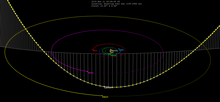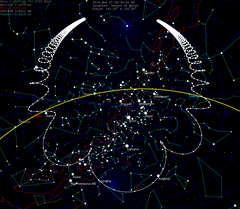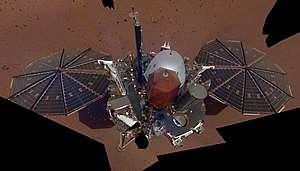C/2018 F4 (PANSTARRS)
C/2018 F4 (PANSTARRS) is a hyperbolic comet (previously classified as A/2018 F4, a hyperbolic asteroid).[2] It was discovered on 17 March 2018 when it was beyond the orbit of Jupiter, 6.4 AU (960 million km) from the Sun.[1] It was quite far from the Sun and turned out to simply be an asteroidal object that was discovered before cometary activity was noticeable. As perihelion (closest approach to the Sun) is inside the orbit of Jupiter, this object should become more active. In April 2018 it was determined to be a hyperbolic comet.[4] Given that the incoming velocity was similar to that of an Oort cloud object, we can very confidently say that it is not of interstellar origin.[5] [6]
 motion of comet through the solar system, with 30-day motion markers | |
| Discovery [1] | |
|---|---|
| Discovered by | Pan-STARRS |
| Discovery site | Haleakala Observatory |
| Discovery date | 17 March 2018 |
| Designations | |
| C/2018 F4 | |
| hyperbolic comet [2] | |
| Orbital characteristics [2] | |
| Epoch 23 March 2018 (JD 2458200.5) | |
| Observation arc | 27 days |
| Perihelion | 3.44584±0.0029 AU |
| Eccentricity | 1.00385±0.0072[lower-alpha 1] (JPL) 1.0130±0.0046 (MPC) |
| Inclination | 78.2971±0.19° |
| Jupiter MOID | 0.60 AU (90 million km) |
| Physical characteristics | |
| Dimensions | 10–20 km (assumed)[3] |
| 11.8±0.5 | |
Overview

It would be no problem to fit a parabolic orbit to the C/2018 F4 data,[2][lower-alpha 1] as used to be done for most short arc comets. The orbital eccentricity is decently constrained at 1.0038±0.0072,[lower-alpha 1] so it could even be a closed orbit with an eccentricity below 1.[2] The velocity of the object currently has an uncertainty of ±0.2 km/s. With a common Oort cloud velocity of roughly 3 km/s (6,700 mph) when inbound 200 AU from the Sun, there is no reason to think 2018 F4 is of interstellar origin.[5]
It will come to perihelion around 3 December 2019 when it will be 3.4 AU from the Sun.[2]
Further observations will be necessary to determine if the orbit is hyperbolic. As a comet this object became known as C/2018 F4 (PANSTARRS).
The somewhat short observation arc of 35 days suggests that before entering the planetary region of the Solar System (epoch 1950), the comet had an orbital period on the order of a hundred thousand years. The heliocentric eccentricity became greater than 1 in November 2016 when the comet was 9.6 AU (1.44 billion km) from the Sun.
| Object | Year | Velocity km/s | # of observations and obs arc |
|---|---|---|---|
| 90377 Sedna | 1746 | 1.99±0.00 | 196 in 9240 days |
| C/1980 E1 (Bowell) | 1765 | 2.95±0.00 | 179 in 2514 days |
| C/1997 P2 (Spacewatch) | 1779 | 2.96±0.01 | 94 in 49 days |
| C/2010 X1 (Elenin) | 1798 | 2.96±0.00 | 2,222 in 235 days |
| C/2012 S1 (ISON) | 1801 | 2.99±0.00 | 6,514 in 784 days |
| C/2008 J4 (McNaught) | 1855 | 4.88±5.44 | 22 in 15 days |
| C/2018 F4 | 1792 | 2.77±0.00 | 255 in 533 days |
| C/1999 U2 (SOHO) | 1947 | 17±447 | 41 in 1 day |
| 1I/2017 U1 (ʻOumuamua) | 1982 | 26.49±0.03 | 121 in 34 days |
At 200 AU from the Sun, the escape velocity from the Sun is 2.98 km/s. In the above table, the only outlier is ʻOumuamua with a confident 34-day observation arc. Comet C/2008 J4 (McNaught) has a short observation arc with large uncertainties. Comet C/1999 U2 (SOHO) has a meaningless 1-day observation arc. Comet C/2018 F4 has a common Oort cloud velocity when 200 AU from the Sun.[5]
Notes
- A/2018 F4 could have an orbital eccentricity as low as 0.996. (Math: 1.0039-0.0072)
References
- "MPEC 2018-F139: A/2018 F4". IAU Minor Planet Center. 2018-03-28. Retrieved 2018-03-28. (AK18F040)
- "JPL Small-Body Database Browser: (A/2018 F4)" (2018-04-13 last obs.). Jet Propulsion Laboratory. Archived from the original on 28 March 2018. Retrieved 17 April 2018.
- "Asteroid Size Estimator". Jet Propulsion Laboratory. Retrieved 28 March 2018.
- "MPEC 2018-H21 : COMET C/2018 F4 (PANSTARRS)". IAU Minor Planet Center. 2018-04-17. Retrieved 2018-04-17. (CK18F040)
- Licandro, Javier; de la Fuente Marcos, Carlos; de la Fuente Marcos, Raúl; de Leon, Julia; Serra-Ricart, Miquel; Cabrera-Lavers, Antonio (28 May 2019). "Spectroscopic and dynamical properties of comet C/2018 F4, likely a true average former member of the Oort cloud". Astronomy and Astrophysics. 625: A133 (6 pages). arXiv:1903.10838. Bibcode:2019A&A...625A.133L. doi:10.1051/0004-6361/201834902.
- de la Fuente Marcos, Carlos; de la Fuente Marcos, Raúl; Licandro, Javier; Serra-Ricart, Miquel; Cabrera-Lavers, Antonio (2 October 2019). "Ordinary Oort Cloud Comets: An Update on the Past and Future Orbital Evolution of C/2018 F4 (PANSTARRS)". Research Notes of the American Astronomical Society. 3 (10): 143. Bibcode:2019RNAAS...3..143D. doi:10.3847/2515-5172/ab4888.
- "HORIZONS Web-Interface". Solar System Dynamics Group. JPL. Results produced with JPL Horizons On-Line Ephemeris System using Soln.date: 2018-Apr-29. Observer Location: "@sun"/ Table settings: "20. Observer range & range-rate", "39. Range & range-rate 3-sigmas". Columns: deldot, RNGRT_3sig
External links
| Wikimedia Commons has media related to C/2018 F4 (PANSTARRS). |

